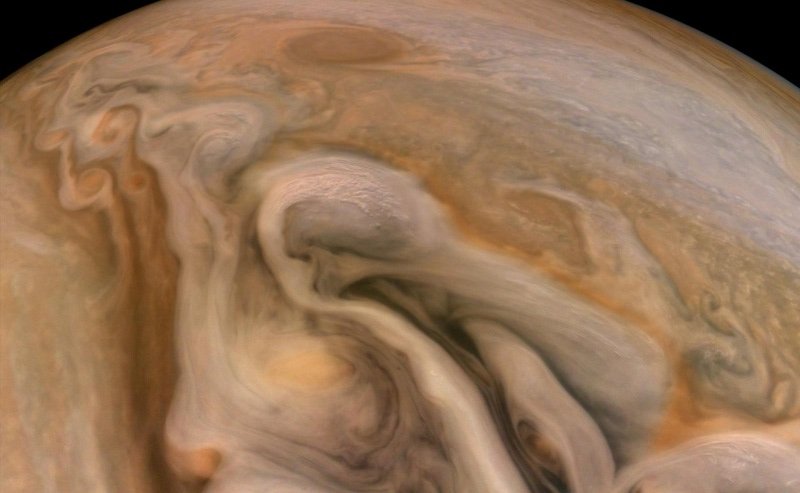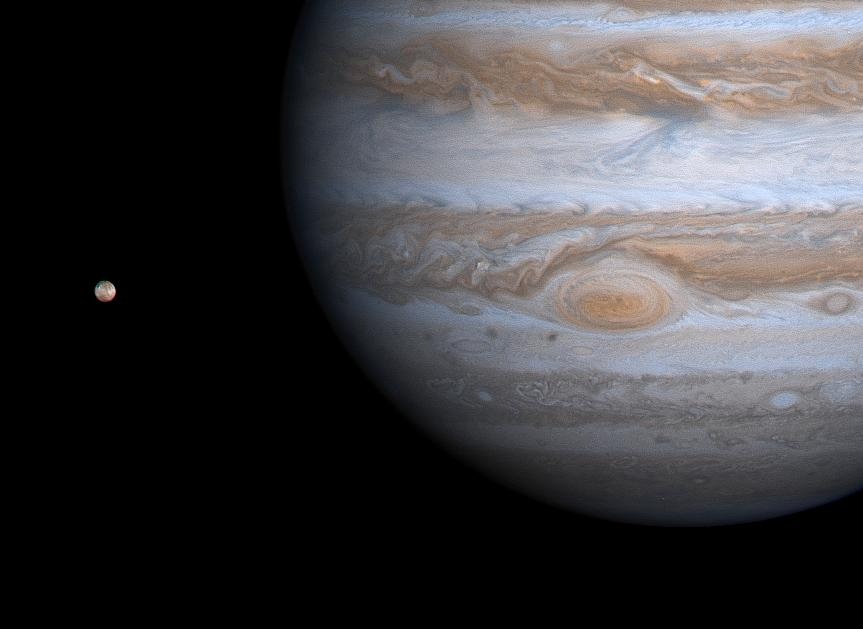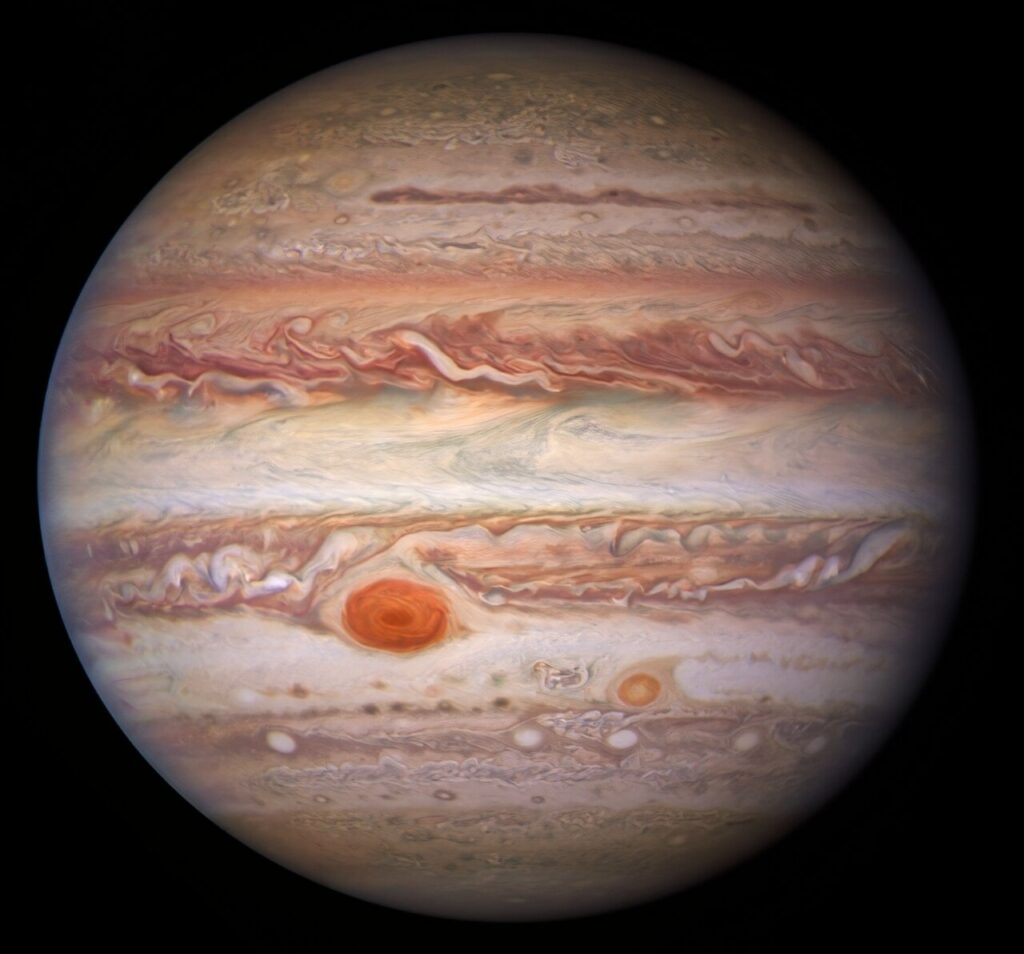Jupiter is the largest planet in our solar system and the fifth planet from the Sun. Jupiter is often referred to as a “gas giant” because it is primarily composed of hydrogen and helium. Unlike terrestrial planets like Earth, which have solid surfaces, Jupiter lacks a solid surface and is instead a massive ball of gas. Here are some key details about this planet:
Size and Distance from the Sun
Jupiter has a diameter of approximately 139,822 kilometers (86,881 miles), making it more than 11 times wider than Earth. It orbits the Sun at an average distance of about 778 million kilometers (484 million miles), placing it beyond the asteroid belt in the outer regions of the solar system.
Composition
Jupiter is a gas giant composed mostly of hydrogen and helium, similar to the composition of the Sun. It does not have a solid surface like terrestrial planets such as Earth and Mars.
Jupiter’s atmosphere is characterized by colorful bands of clouds, with the most prominent features being its Great Red Spot and various cloud bands. The Great Red Spot is a massive storm larger than Earth, which has been observed for centuries.
Jupiter’s atmosphere also contains other storms, including cyclones and anticyclones, and displays complex weather patterns.

Orbital Period
Jupiter takes approximately 11.86 Earth years to complete one orbit around the Sun. This long orbital period means that Jupiter’s seasons are significantly longer than those on Earth.
It’s axial tilt is relatively small compared to some other planets in the solar system. It is just 3.13 degrees, which is much less than Earth’s axial tilt of approximately 23.5 degrees. This means that Jupiter experiences relatively mild seasonal variations compared to Earth.
Moons
Jupiter has a vast system of moons, with over 90 known moons orbiting the planet. Its four largest moons, known as the Galilean moons (Io, Europa, Ganymede, and Callisto), were discovered by the astronomer Galileo Galilei in 1610 and are among the most intriguing bodies in the solar system. These moons exhibit diverse features, including active volcanoes (Io), icy crusts and subsurface oceans (Europa), and a complex geological history (Ganymede and Callisto).

Magnetosphere
Jupiter has a strong magnetic field, the largest of any planet in the solar system. Its magnetosphere extends far beyond the planet and interacts with its moons and the solar wind, creating intense radiation belts around the planet.
Extreme Temperatures
The upper atmosphere of Jupiter, where most of its visible clouds and storms are located, has temperatures that typically range from about -145°C (-234°F) to -108°C (-162°F). These temperatures can vary depending on factors such as latitude, altitude, and local weather patterns.
As you descend deeper into Jupiter’s atmosphere, temperatures increase due to the compression of gases. At the level where the atmospheric pressure is comparable to Earth’s surface pressure (about 1 bar), temperatures are estimated to be around 0°C (32°F) to 20°C (68°F). However, the exact temperature profile at deeper layers is not well understood.
Exploration
Jupiter has been the target of several space missions, including NASA’s Galileo spacecraft, which orbited Jupiter from 1995 to 2003, and the Juno spacecraft, which arrived at Jupiter in 2016 and is currently in orbit around the planet, studying its atmosphere, magnetic field, and interior structure.

Observation
Jupiter is easily visible to the unaided eye and is one of the brightest objects in the night sky. It is often observed with a telescope, allowing for detailed views of its atmospheric bands, the Great Red Spot, and its moons.
The best time to observe Jupiter is during opposition, which is when the planet is directly opposite the Sun in the sky as seen from Earth. At opposition, Jupiter rises as the Sun sets and sets as the Sun rises, making it visible all night long. Opposition occurs roughly once every 13 months, and during this time, Jupiter is at its closest approach to Earth, appearing larger and brighter in the sky.
While opposition provides the best viewing conditions, Jupiter remains visible and prominent in the sky for several weeks before and after opposition.
Jupiter goes through conjunctions when it is on the opposite side of the Sun from Earth. During conjunction, Jupiter is too close to the Sun to be observable, as it is lost in the Sun’s glare.
Clear, dark skies away from light pollution provide the best conditions for observing Jupiter and its details. Check weather forecasts and plan observations on nights with clear skies and minimal atmospheric turbulence for the best views.



